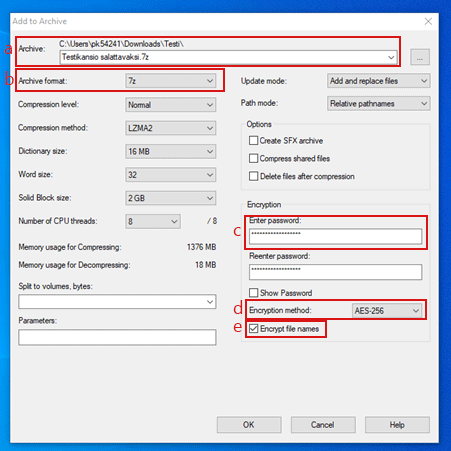Encrypting files
Always encrypt confidential information or material containing personal data if you need to process it via email. Please note! In most cases, the attachment must be encrypted separately.
Use Microsoft 365 encryption in situations where the information to be protected is included as text in the text field of the message or in a single MS Office attachment (Word, Excel, PowerPoint). Other attachments are encrypted as the message travels (as if in an envelope), but when the message is opened, the attachments are also readable.
If an MS Office file containing confidential or personal data is processed in any other way, for example shared via Teams, it must be encrypted separately with a password Protect a document with a password - Microsoft Support
Encrypting PDF files
The pdf file contains the following information about encrypting PDF files:
files containing confidential information are encrypted as follows. This instruction concerns the PDF-Xchange Editor programme, of which a free version and a wider version subject to a charge are available. Both versions have the encryption feature.
- Create and open a .pdf document as usual.
- Go to the Protect tab and click Security Properties.
- Choose Password Security in the drop-down menu.
- A new window opens where you can key in the password. Tick Require password to open the document and write the same password in both fields. Write down the password. Approve the password by clicking OK.
- You get an alert reminding you that the password will not be valid until you save your .pdf document. Approve the alert by clicking OK.
- Save the document as usual with a name and in a place of your choosing.
Opening an encrypted PDF file
- Double-click the PDF file.
- When the alert box appears, feed in the password to open the document.
Encrypting other files
When you have several files and/or they are other than Office file types, use the 7-Zip programme for encrypting information, which can be downloaded to TUNI computers form Software Center. The programme is also suited for processing special personal data (1R) if the data is encrypted according to the instructions below.
On a Mac, PDF encryption or password protection is done with the built-in Preview program.
A short example
In a research project, you need to transfer research data to a project member working at another organisation. You have ensured that you have the right to transfer the data and that the recipient can also process the data in the correct manner; also remember the log. On your encrypted (eg Bitlocker in TUNI Win computers) hard drive, you now you have a version of the data that is suitable for transfer in its own folder.
- Pack and encrypt the folder with the 7-Zip programme (format 7z, encryption method AES-252, recommended length of password at least 16 characters)
- Please note that the recipient must also have the 7-Zip programme to decode the encryption.
- Send the encrypted package to the recipient as an attachment to a secure Office 365 email or with Funet Filesender if the file is too large for email.
- Send the password required to open the file to the recipient with another medium, for example, by telephone or registered post.
- PLEASE NOTE! Take special care to preserve the password to the encrypted file because it is not possible to open the package without it.
Step by step instructions
- Open the 7-Zip programme and find the encrypted material (File -> Open).
- Choose the folder or file and start packing/encrypting -> Add.
- Make the necessary choices (See the picture below.)
a. Name the package in a manner that does not reveal its contents too much.
b. Choose 7z as the format. Please note! The package can only be opened with the 7-Zip programme, meaning that the recipient must also have the programme.
c. Add the password. The recommended length of the password is 20 characters including numbers and special characters.
d. Choose AES-256 as the encryption method.
e. Tick the box to encrypt the file names.

- When you approve the choices by clicking OK, the programme creates an encrypted package with the name you have chosen in the same folder as the original material.
- You can decrypt the encrypted 7z package, for example, by clicking the package with the right button of the mouse -> 7-Zip -> Extract Here.
- When prompted, give the password defined at encryption to decrypt the package.